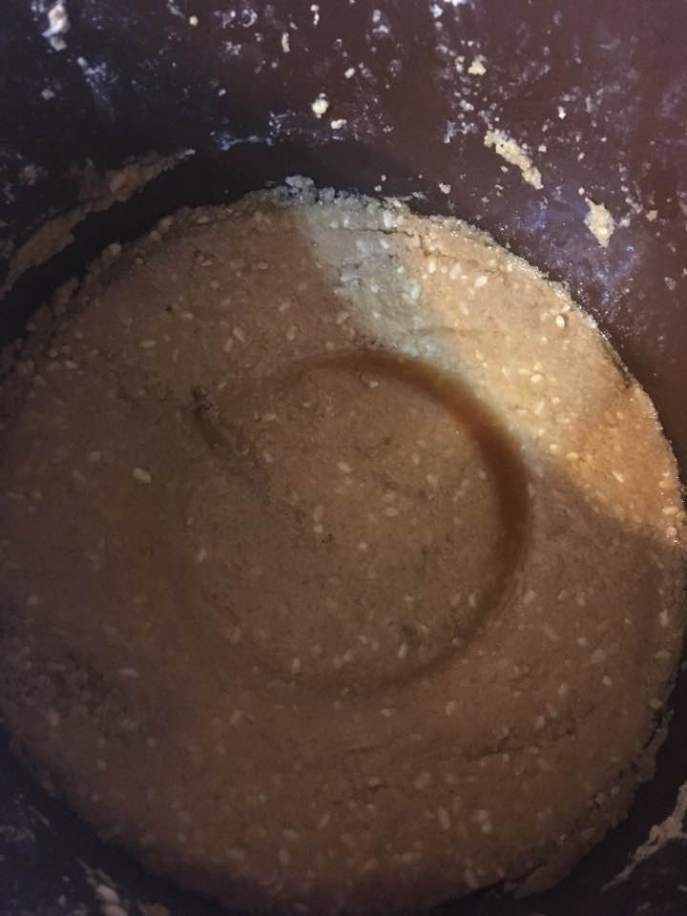
Okay, so I started the dandelion wine post last month and then I sort of forgot about it because, with wine, there’s just an awful lot of waiting around. And then I rushed through it because I was really excited about this next venture, homemade miso! I started the miso project back in the fall, using the very easy-to-follow instructions by the fabulous Nancy Singleton Hachisu in her excellent Preserving the Japanese Way.
The whole thing is actually pretty pricey because you have to get a couple pounds of dried soybeans (I opted for organic) and order koji starter online and then pay a lot for shipping because it’s a live product and needs to stay cold. You also need a lot of salt, though that’s at least cheap. Anyway, I’ve just been through my photos and apparently I didn’t document the process well, which is a little sad because there’s some fun throwing of balls of soybean-and-koji balls into the fermentation jug, and some steps that make you question your sanity a bit. Lacking my own photos, here are some I stole from the Permaculture Research Institute:
The basic process is that you soak and the cook the beans, drain them, and then mash them. I did this by hand, so my finished miso has more texture than commercial kinds. After the beans are mashed up, you add salt and koji, squeeze together handfuls, and then throw those into the fermentation pot so they make a satisfying “thwack-splat!” You have to throw them hard because you’re trying to get rid of air pockets. Then you sprinkle on more salt and cover the whole with a tight-fitting lid. I used a plate that fits right into my fermenting crock. Over this you place a cloth (I used a tea towel) and then a heavy weight (I used a gallon wine carboy filled with water) and drape another cloth over the top and tie it around the base. Ms. Singleton Hachisu assures the reader that the cloth “will become scarily dusted with green mold spores” because it’s actually the mold barrier. Then you really just let the whole thing sit round outside. I started mine in September or October and let it ferment until today. Traditionally, when the weather warms, you just start stirring and let it hang out through summer but when I opened it up today it smelled great so I decided it was done. Normally it apparently goes through summer.
Because of the expense and the fact that the whole thing stays covered, I was quite nervous but it turned out really well, and there’s a lot of it!  Six pounds, apparently. I have mashed it down better than in these photos so there aren’t air pockets and stuck it in the fridge. But before I did that, of course, we needed a taste:
Six pounds, apparently. I have mashed it down better than in these photos so there aren’t air pockets and stuck it in the fridge. But before I did that, of course, we needed a taste:  . It’s rich and flavorful and so satisfying! The texture is a little surprising if you’re used to the smooth stuff but the bits are just like amazake (which makes sense since they’re both made with koji) so they’re not objectionable.
. It’s rich and flavorful and so satisfying! The texture is a little surprising if you’re used to the smooth stuff but the bits are just like amazake (which makes sense since they’re both made with koji) so they’re not objectionable.
The only problem is that I now have 6 pounds of miso taking up space in my fridge, but I think that’s a problem I can handle.


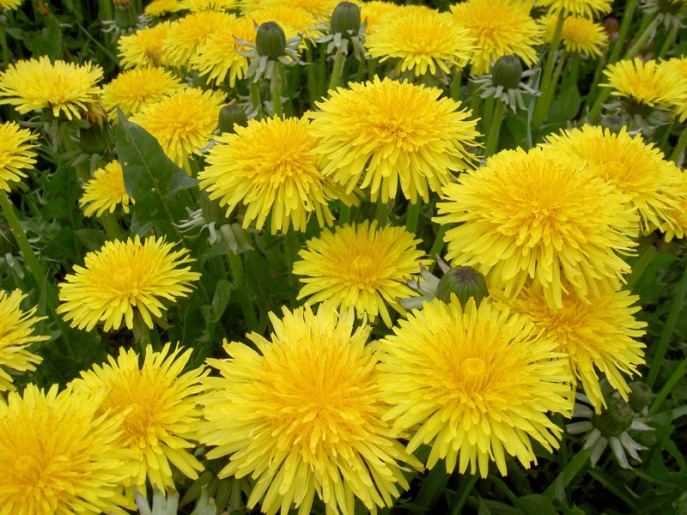
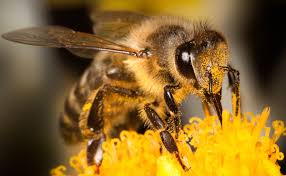
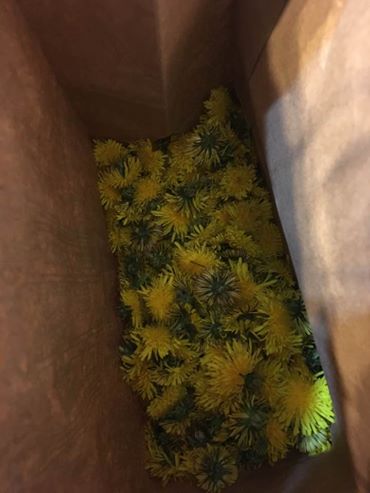 I use a plastic 4-cup measure paper bag with handles or a wicker basket– fill the measuring cup once, dump it into the bag, and refill. This usually takes me around half an hour if I’m at peak season. Earlier in the morning is better, as a rule, but even late morning works. Afternoons are hard as the flowers often close in the heat of the day, and overcast days don’t work well for the same reason. Watch for insects when you harvest, and try to remove them as you go.
I use a plastic 4-cup measure paper bag with handles or a wicker basket– fill the measuring cup once, dump it into the bag, and refill. This usually takes me around half an hour if I’m at peak season. Earlier in the morning is better, as a rule, but even late morning works. Afternoons are hard as the flowers often close in the heat of the day, and overcast days don’t work well for the same reason. Watch for insects when you harvest, and try to remove them as you go. At this point, you will need one of your few specialized ingredients, a crushed
At this point, you will need one of your few specialized ingredients, a crushed 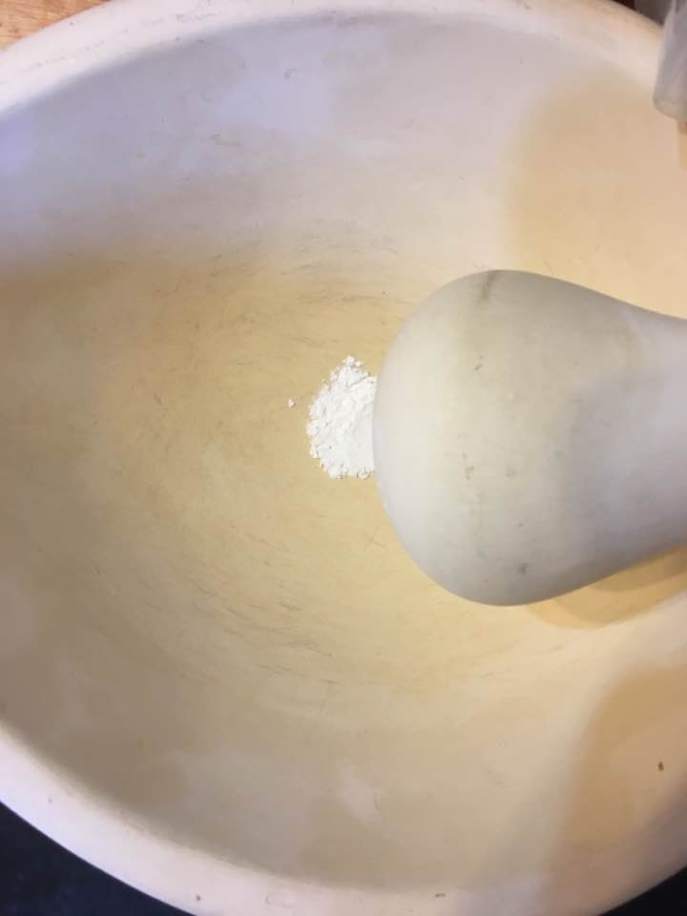 which you can get from wine supply shops like
which you can get from wine supply shops like 
 You stand on the lip in the front of the photo and turn the crank. It works well and is easy to disassemble, so it’s in the shed now, with the press. (Side note: what a messy kitchen! I should have cleaned up before the photo, but instead you can see the box the apples came in, my shopping bags hanging from the door, the primary fermentor, rumtopf aging in the corner….) Anyway, I got a little over a gallon of juice from the apples, so that’s now in a couple of secondaries. No photos because it’s just a fizzy brown-yellow like last year’s.
You stand on the lip in the front of the photo and turn the crank. It works well and is easy to disassemble, so it’s in the shed now, with the press. (Side note: what a messy kitchen! I should have cleaned up before the photo, but instead you can see the box the apples came in, my shopping bags hanging from the door, the primary fermentor, rumtopf aging in the corner….) Anyway, I got a little over a gallon of juice from the apples, so that’s now in a couple of secondaries. No photos because it’s just a fizzy brown-yellow like last year’s.

 I did a batch flavored with lemon rind and one with orange. You can see the walnuts floating to the top of the jars, even though I cooled them upside-down. We had some this morning on biscuits and it’s very tasty. Funny how the foxiness doesn’t matter in sweet applications like conserve and Welch’s grape juice.
I did a batch flavored with lemon rind and one with orange. You can see the walnuts floating to the top of the jars, even though I cooled them upside-down. We had some this morning on biscuits and it’s very tasty. Funny how the foxiness doesn’t matter in sweet applications like conserve and Welch’s grape juice. I simmered it for about 20 minutes and then strained it. I’m letting it cool a bit, and then I’ll press the juice out of the fruit and figure out what to do with the syrup. I might freeze it in an ice cube tray for handy single-servings for cold season. And since the wine is so good, I’ll make another batch with dried fruit once I have a free primary fermentor. If I get enough at some point, I will try elderflower wine, too, though I’m more excited about what I can make from the fruit.
I simmered it for about 20 minutes and then strained it. I’m letting it cool a bit, and then I’ll press the juice out of the fruit and figure out what to do with the syrup. I might freeze it in an ice cube tray for handy single-servings for cold season. And since the wine is so good, I’ll make another batch with dried fruit once I have a free primary fermentor. If I get enough at some point, I will try elderflower wine, too, though I’m more excited about what I can make from the fruit.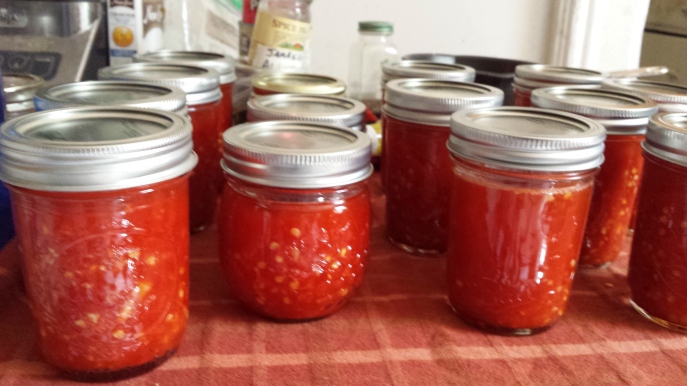
 After it sat around for a while (I presume this is to meld the flavors, since it doesn’t seem to ferment), I poured off the vinegar and reduced it, then added the vegetables and cooked them until they were soft, and then blended the whole thing up:
After it sat around for a while (I presume this is to meld the flavors, since it doesn’t seem to ferment), I poured off the vinegar and reduced it, then added the vegetables and cooked them until they were soft, and then blended the whole thing up:  . So I now have some for us and some to share! The only real drawback to making it is that it’s kind of a pain to blend in the food processor because it leaks, and the blender will be tricky because of the heat. I think I’ll try the immersion blender next time. I also found a recipe online for a fermented version (obviously not canned), so that seems worth trying out, too. So there you have it: a day mostly wasted, except for 14 jars of Sriracha.
. So I now have some for us and some to share! The only real drawback to making it is that it’s kind of a pain to blend in the food processor because it leaks, and the blender will be tricky because of the heat. I think I’ll try the immersion blender next time. I also found a recipe online for a fermented version (obviously not canned), so that seems worth trying out, too. So there you have it: a day mostly wasted, except for 14 jars of Sriracha.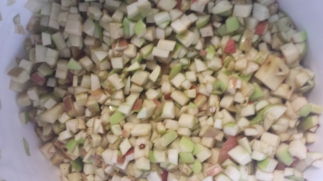 It only took an hour or so, I think, but I had to put a bandage on my right hand where it met the knife handle. To these I added a gallon of water, yeast nutrient, and a packet of Champagne yeast. I’m supposed to let it all sit, stirring several times a day, for about a week. After that, I will press the apples to get all that good juice out, and add sugar (how much depends on how much juice I get, so Gerry’s going to rig something for my fruit press to sit on) and whatever else is needed.
It only took an hour or so, I think, but I had to put a bandage on my right hand where it met the knife handle. To these I added a gallon of water, yeast nutrient, and a packet of Champagne yeast. I’m supposed to let it all sit, stirring several times a day, for about a week. After that, I will press the apples to get all that good juice out, and add sugar (how much depends on how much juice I get, so Gerry’s going to rig something for my fruit press to sit on) and whatever else is needed. 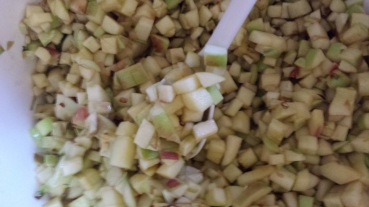 The apples are browning less than I thought they would, and they make a pleasing fizz when I stir.
The apples are browning less than I thought they would, and they make a pleasing fizz when I stir. Unfortunately for me, the first step in real wine, unlike my normal country wine, is to pick the grapes, removing stems and other debris, which turns out to be hard physical labor. It took ages! I finally finished at around 10:30, having spent over 2 hours standing at the sink and getting pruny fingers from the water the grapes here in. (I also had to run outside a few times with the small survivors of my picking: a beetle, several spiders, and a ladybug.) So I covered the bowl with a towel, took a bath for my aching feet and back, and went to bed. This morning, Jolyon and I crushed the grapes by hand, though after a few minutes, he resorted to the potato ricer, which did quite a nice job. I just kept using my hands, which was sort of satisfying, even if I did feel a lot like Lucy stomping grapes. It took us a little less than an hour, I think, and I had to add a little more than 2 cups of sugar to get my specific gravity up to 1.100. (I don’t actually have an acid tester so I will have to trust that these are appropriately acidic, though the extremely nice Rykers Cellars guy offered to test it for me.) At first I had all of this in a 2-gallon bucket, but my instructions say to be sure a fifth of the primary is empty because the must expands, so I moved it (messily) to my big bulb fermentor. I have the grapes tied in a bag, which doesn’t really fit the mouth of the bulb, so I might untie and dump, though that will mean straining afterwards. We’ll see. Anyway, it doesn’t start off a nice color.
Unfortunately for me, the first step in real wine, unlike my normal country wine, is to pick the grapes, removing stems and other debris, which turns out to be hard physical labor. It took ages! I finally finished at around 10:30, having spent over 2 hours standing at the sink and getting pruny fingers from the water the grapes here in. (I also had to run outside a few times with the small survivors of my picking: a beetle, several spiders, and a ladybug.) So I covered the bowl with a towel, took a bath for my aching feet and back, and went to bed. This morning, Jolyon and I crushed the grapes by hand, though after a few minutes, he resorted to the potato ricer, which did quite a nice job. I just kept using my hands, which was sort of satisfying, even if I did feel a lot like Lucy stomping grapes. It took us a little less than an hour, I think, and I had to add a little more than 2 cups of sugar to get my specific gravity up to 1.100. (I don’t actually have an acid tester so I will have to trust that these are appropriately acidic, though the extremely nice Rykers Cellars guy offered to test it for me.) At first I had all of this in a 2-gallon bucket, but my instructions say to be sure a fifth of the primary is empty because the must expands, so I moved it (messily) to my big bulb fermentor. I have the grapes tied in a bag, which doesn’t really fit the mouth of the bulb, so I might untie and dump, though that will mean straining afterwards. We’ll see. Anyway, it doesn’t start off a nice color. 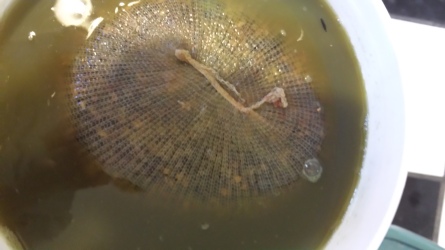 But this photo is from almost immediately after crushing, and the skins are all still in there, so it should look much nicer soon. So far, it’s just the juice, sugar, and a crushed Campden. I’ll add yeast this evening, though I haven’t decided what kind yet– probably Montpelier. I think I’ll try a second-run batch too, since the actual wine grape thing is so exciting. (I’ll need to get grape concentrate but that should be easy enough.) Regular wine a different process, since I didn’t really need to add much of anything else. Here’s hoping it’s good!
But this photo is from almost immediately after crushing, and the skins are all still in there, so it should look much nicer soon. So far, it’s just the juice, sugar, and a crushed Campden. I’ll add yeast this evening, though I haven’t decided what kind yet– probably Montpelier. I think I’ll try a second-run batch too, since the actual wine grape thing is so exciting. (I’ll need to get grape concentrate but that should be easy enough.) Regular wine a different process, since I didn’t really need to add much of anything else. Here’s hoping it’s good!

 The recipe called for Pomona’s Universal Pectin, which I couldn’t find, so I added regular pectin. Which apparently needs to be heated to do its thing. So this is very liquid, but I’ll taste it tonight to see if it’s good. Kind of a weird recipe, calling for salt and maple syrup and crushed berries, but it seemed worth a try, anyway. I added one last peach I’d somehow forgotten to can up, so at least there’s that for texture. (The grapes went through the food mill, since they’re full of seeds.)
The recipe called for Pomona’s Universal Pectin, which I couldn’t find, so I added regular pectin. Which apparently needs to be heated to do its thing. So this is very liquid, but I’ll taste it tonight to see if it’s good. Kind of a weird recipe, calling for salt and maple syrup and crushed berries, but it seemed worth a try, anyway. I added one last peach I’d somehow forgotten to can up, so at least there’s that for texture. (The grapes went through the food mill, since they’re full of seeds.) This is a favorite of ours, with a hint of sweetness from orange juice (or raisins last time) and some heat from jalapenos. It’s tasty with rice or in sandwiches or as a side dish, or even with an actual curry. Good stuff. When I finished that, I did a quarter-pound of whole-leaf basil
This is a favorite of ours, with a hint of sweetness from orange juice (or raisins last time) and some heat from jalapenos. It’s tasty with rice or in sandwiches or as a side dish, or even with an actual curry. Good stuff. When I finished that, I did a quarter-pound of whole-leaf basil  which looks kind of awful but smells great. It’s just the basil leaves massaged with a small quantity of salt, and yes, that is the whole quarter of a pound. Apparently the flavor gets very concentrated, and you use it like fresh. I might get more this weekend and top this jar off, too. I love the idea of year-round basil. In previous years, I’ve made pesto and frozen it in ice cube trays, but stuff gets so buried in the freezer that I always find bits of it from 2 years ago, freezer-burned and sort of tragic.
which looks kind of awful but smells great. It’s just the basil leaves massaged with a small quantity of salt, and yes, that is the whole quarter of a pound. Apparently the flavor gets very concentrated, and you use it like fresh. I might get more this weekend and top this jar off, too. I love the idea of year-round basil. In previous years, I’ve made pesto and frozen it in ice cube trays, but stuff gets so buried in the freezer that I always find bits of it from 2 years ago, freezer-burned and sort of tragic. . This unprepossessing photo is the inside of the fermentation crock, with a layer of plastic wrap directly over the chopped veg, a plate on top of that, and a jar of cornstarch as a weight. I keep the crock covered with a dishcloth, which you can see in the earlier photos, behind the other jars. The salsa is excellent, in any case, and really worth making. It’s also pretty simple: 3 pounds of sweet peppers, 1 pound of hot, a couple sweet onions, 3 or 4 gloves of garlic, and salt. You just whir everything in the food processor, though next time I’ll do that in 2 batches, since it leaked pepper juice all over the place. Then you let it ferment for a few days until it tastes good.
. This unprepossessing photo is the inside of the fermentation crock, with a layer of plastic wrap directly over the chopped veg, a plate on top of that, and a jar of cornstarch as a weight. I keep the crock covered with a dishcloth, which you can see in the earlier photos, behind the other jars. The salsa is excellent, in any case, and really worth making. It’s also pretty simple: 3 pounds of sweet peppers, 1 pound of hot, a couple sweet onions, 3 or 4 gloves of garlic, and salt. You just whir everything in the food processor, though next time I’ll do that in 2 batches, since it leaked pepper juice all over the place. Then you let it ferment for a few days until it tastes good.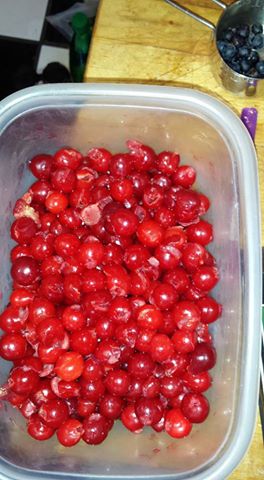

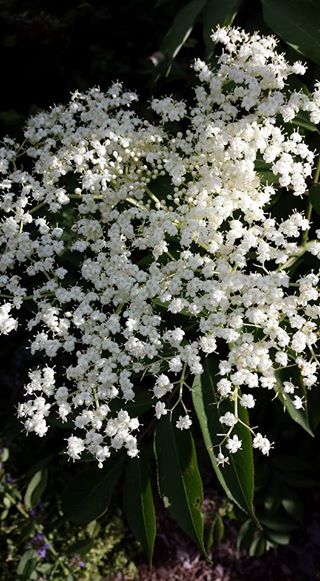






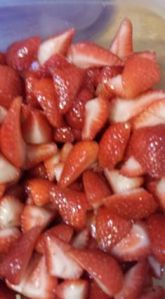

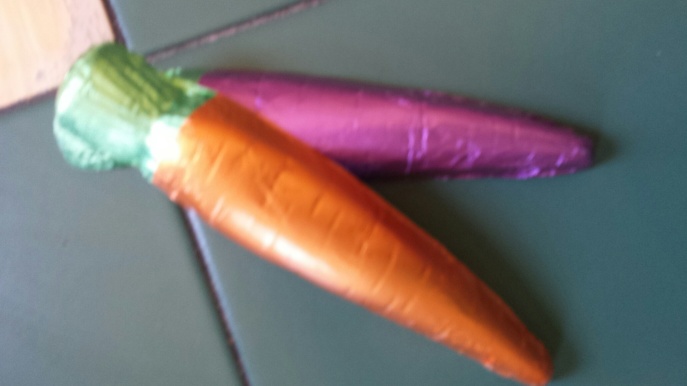 Well, it’s suddenly Easter. I’ve done kind of a lot of nothing, though I did get us these pretty Lake Champlain chocolate carrots, and I gave the dogs the end of a real carrot I was grating. So I guess that’s something.
Well, it’s suddenly Easter. I’ve done kind of a lot of nothing, though I did get us these pretty Lake Champlain chocolate carrots, and I gave the dogs the end of a real carrot I was grating. So I guess that’s something.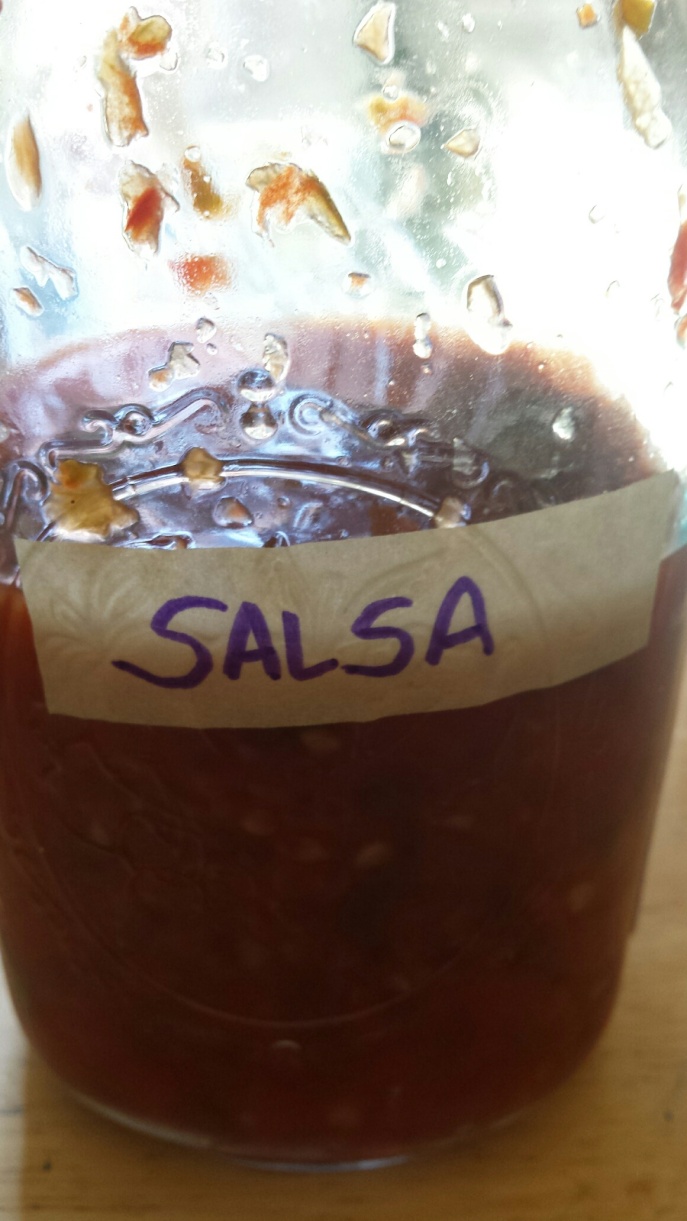 I may increase the jalapeno ratio next time, though. For this one, I chopped up all the peppers, onions, and garlic in the food processor and salt, so everything is quite small–salsa, after all, right? It was a little tricky to keep the little bits of vegetable submerged, but a bit of plastic wrap tucked around the sides did the trick. In summer, I’m going to preserve some of my grape leaves to use instead of plastic wrap. This one had to sit for 2 weeks, but it’s really good. It just tastes like a really nice salsa, and you can’t really tell it doesn’t have tomato in it. Nice as a dressing for taco salad, too, mixed with a little olive oil.
I may increase the jalapeno ratio next time, though. For this one, I chopped up all the peppers, onions, and garlic in the food processor and salt, so everything is quite small–salsa, after all, right? It was a little tricky to keep the little bits of vegetable submerged, but a bit of plastic wrap tucked around the sides did the trick. In summer, I’m going to preserve some of my grape leaves to use instead of plastic wrap. This one had to sit for 2 weeks, but it’s really good. It just tastes like a really nice salsa, and you can’t really tell it doesn’t have tomato in it. Nice as a dressing for taco salad, too, mixed with a little olive oil. I love the idea, and I love Brussels sprouts, but these are a little disappointing. I was hoping they would take on more of a coleslaw texture, but they’ve retained their rawness, and the spicy flavor really only hits when you get one of the sliced jalapenos. Still, the sprouts are good sliced up in salads, and they’re probably doing magical things for our microbiomes. I’m not quite sure how we would know this, so let’s just assume it’s true. There’s some fairly compelling research out there about gut health having an impact on overall health, after all. Maybe we can get paid as poop-donors for fecal transplants or something. (No, seriously, that’s a Thing! http://thefecaltransplantfoundation.org/what-is-fecal-transplant/)
I love the idea, and I love Brussels sprouts, but these are a little disappointing. I was hoping they would take on more of a coleslaw texture, but they’ve retained their rawness, and the spicy flavor really only hits when you get one of the sliced jalapenos. Still, the sprouts are good sliced up in salads, and they’re probably doing magical things for our microbiomes. I’m not quite sure how we would know this, so let’s just assume it’s true. There’s some fairly compelling research out there about gut health having an impact on overall health, after all. Maybe we can get paid as poop-donors for fecal transplants or something. (No, seriously, that’s a Thing! http://thefecaltransplantfoundation.org/what-is-fecal-transplant/) I don’t actually ever make sun tea, but the jar has turned out to be a good size, and I think it was something like $2. It’s perfect for these ferments. It’s big enough that I can pack everything in, with lots of headspace, and then the Ziploc with brine on top. Fermenting veg bubble up a lot of excess liquid, so I’m keeping the jar on top of a disposable pie plate. (No idea why I even had a disposable pie plate, but it was in the cupboard.) This will ferment on the counter for a couple of weeks. Not sure what will be next, but we do tend to like the spicy ones a lot.
I don’t actually ever make sun tea, but the jar has turned out to be a good size, and I think it was something like $2. It’s perfect for these ferments. It’s big enough that I can pack everything in, with lots of headspace, and then the Ziploc with brine on top. Fermenting veg bubble up a lot of excess liquid, so I’m keeping the jar on top of a disposable pie plate. (No idea why I even had a disposable pie plate, but it was in the cupboard.) This will ferment on the counter for a couple of weeks. Not sure what will be next, but we do tend to like the spicy ones a lot.